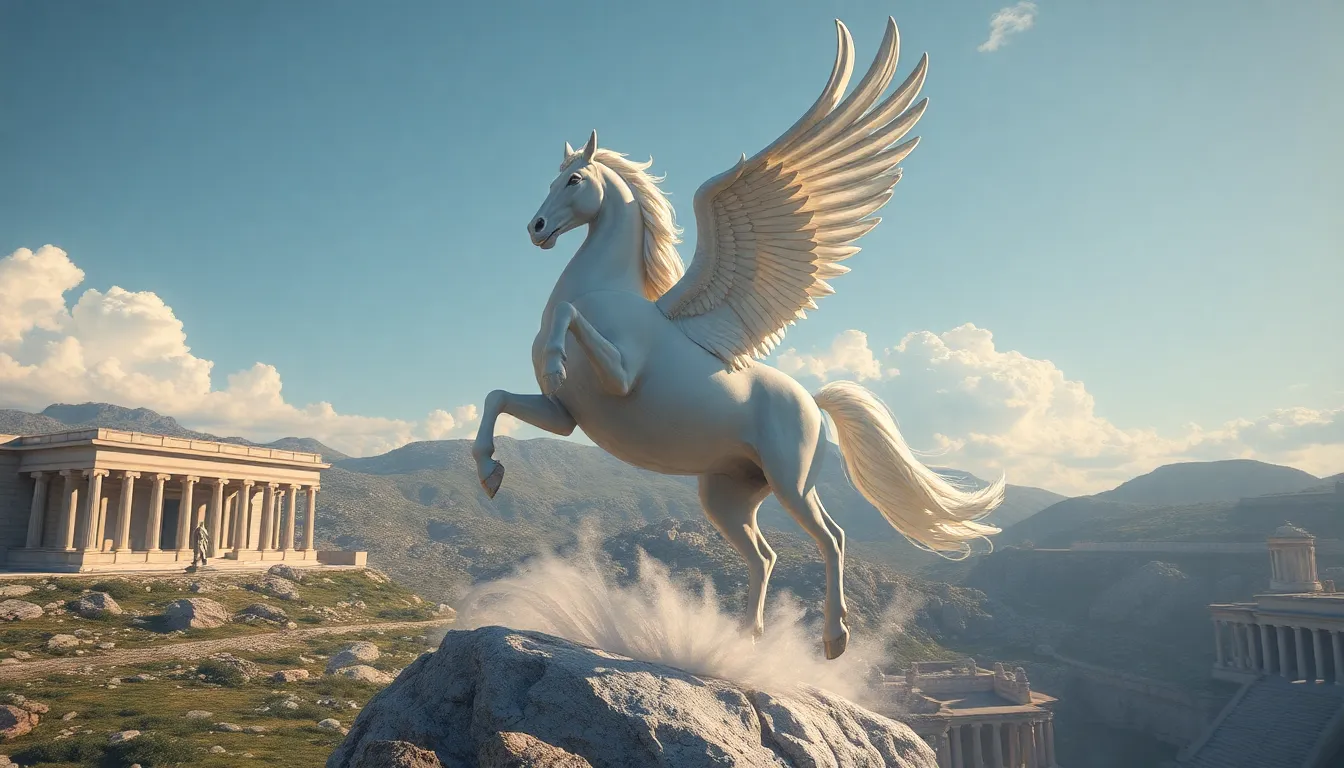The Connection Between Pegasus and the Arts: A Mythological Overview
I. Introduction
Pegasus, the magnificent winged horse of Greek mythology, has captivated imaginations for centuries. Born from the blood of the Gorgon Medusa, Pegasus embodies the ideals of beauty, inspiration, and the pursuit of knowledge. His significance extends beyond mythology, as he has become a powerful symbol within the arts, inspiring countless creators across various mediums.
This article explores the multifaceted relationship between Pegasus and the arts. We will delve into his origins in mythology, his role as a muse in literature, his representation in visual arts, and his influence in music and performing arts. Additionally, we will discuss the modern cultural impact of Pegasus and analyze the symbolism associated with him across different art forms.
II. The Origins of Pegasus in Greek Mythology
Pegasus was born from the blood of Medusa when she was slain by the hero Perseus. This remarkable birth is not only significant in the context of Pegasus’s existence but also serves as a metaphor for the birth of inspiration from chaos and violence.
Key myths surrounding Pegasus include:
- The Capture by Bellerophon: Bellerophon, a hero of Greek legend, tamed Pegasus with the help of a golden bridle given to him by Athena. Together, they undertook numerous quests, including slaying the Chimera.
- The Flight to Olympus: After completing his heroic deeds, Pegasus ascended to Mount Olympus, where he became a companion of the gods and was transformed into a constellation.
Pegasus symbolizes various themes in ancient Greece, such as creativity, poetic inspiration, and the pursuit of enlightenment. His image often represented the transcendence of human limitations and the quest for higher understanding.
III. Pegasus as a Muse in Literature
Pegasus has been a source of inspiration in ancient Greek poetry and drama. Poets like Hesiod and Pindar referenced him, associating the winged horse with the Muses, the goddesses of the arts and sciences.
His influence extends to later literary works, where Pegasus often embodies the ideals of artistic inspiration and creativity. Notable mentions of Pegasus include:
- The Iliad by Homer: While Pegasus does not appear directly, the themes of heroism and divine intervention resonate with his narrative.
- The Faerie Queene by Edmund Spenser: Pegasus symbolizes the poet’s creative journey, representing the aspiration to attain artistic perfection.
In literature, Pegasus serves as a powerful symbol of inspiration, urging writers and artists to explore the depths of their creativity and to rise above earthly limitations.
IV. The Representation of Pegasus in Visual Arts
The depiction of Pegasus in visual arts has evolved significantly over time. From ancient pottery and sculptures to Renaissance paintings, Pegasus has been portrayed in various styles and contexts.
Historical depictions of Pegasus include:
- Greek Pottery: Early representations, often in black-figure or red-figure styles, showcased Pegasus in mythological scenes.
- Renaissance Art: Artists like Sandro Botticelli and Leonardo da Vinci depicted Pegasus in the context of classical mythology, emphasizing his divine nature.
The evolution of Pegasus’s portrayal mirrors changes in artistic techniques and cultural values. Notable artists who featured Pegasus include:
- Alfred Lord Tennyson: His poem The Flight of Pegasus reflects the romantic ideals of the time.
- Paul Gauguin: In his works, Gauguin employs the image of Pegasus to evoke emotion and exotic beauty.
V. Pegasus in Music and Performing Arts
Pegasus has also inspired various musical compositions, ranging from classical symphonies to modern scores. His character often symbolizes freedom and transcendence, making him a fitting subject for exploration in music.
Musical compositions inspired by Pegasus include:
- Pegasus by Karlheinz Stockhausen: A contemporary piece that captures the essence of flight and freedom.
- The Pegasus Suite by David Amram: A blend of orchestral and folk elements that celebrates the spirit of Pegasus.
In the realm of ballet and theater, Pegasus often symbolizes the artistic journey. Productions like Pegasus: The Musical explore themes of aspiration and creativity through dance and performance. Contemporary interpretations continue to adapt the story of Pegasus, reflecting modern values and artistic expressions.
VI. Modern Cultural Impact of Pegasus
Today, Pegasus remains a prominent figure in popular culture. From films and literature to video games and merchandise, the image of the winged horse endures.
Some examples of Pegasus in modern media include:
- Film: In movies like “Clash of the Titans,” Pegasus is portrayed as a loyal companion to heroes.
- Literature: In Rick Riordan’s “Percy Jackson” series, Pegasus is reimagined as a central character, appealing to a younger audience.
This resurgence of interest in Pegasus highlights his enduring relevance, as contemporary artists and storytellers reimagine him to convey themes of heroism, adventure, and the quest for knowledge.
VII. The Symbolism of Pegasus in the Arts
The themes associated with Pegasus resonate across various art forms, embodying concepts such as:
- Creativity: Pegasus symbolizes the spark of inspiration that drives artists to create.
- Freedom: His ability to soar through the skies represents the liberation of the creative spirit.
- Transformation: Pegasus’s journey from a mythical creature to a symbol of artistic aspiration reflects the transformative power of art.
Today, Pegasus continues to inspire artists, reminding them of the interconnectedness of creativity, mythology, and the human experience. His legacy as a muse endures, encouraging new generations to explore their artistic potential.
VIII. Conclusion
Pegasus stands as a significant figure in the arts, bridging the realms of mythology and creative expression. His origins in Greek mythology, role as a muse in literature, representation in visual arts, and influence in music highlight the diverse ways in which he inspires artists.
The enduring legacy of Pegasus illustrates the profound connection between mythology and artistic expression. As artists continue to draw upon his image and symbolism, they reaffirm the timeless relevance of Pegasus in contemporary culture. Ultimately, Pegasus serves as a reminder of the boundless possibilities of creativity and the pursuit of inspiration.




